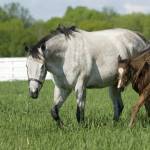Managing Early-Season Heat Cycles in Mares

Horse breeders have always had a situation in which business management and nature seem to be on different wavelengths.
Without intervention, mares naturally begin to come into heat in mid to late spring, meaning that their foals will be born when the weather is reasonably warm the next year. Many breeders, however, want to have foals born earlier in the year. This is especially true for breeders of Thoroughbred horses, as foals born any time during a calendar year are officially a year older on January 1 of the following year.
Thus, foals born in late spring or early summer may be as much as six months younger than others in their training group. This age gap is a significant disadvantage when they reach the racetrack and are asked to compete against more mature horses.
The cue for mares to begin to cycle is lengthening hours of daylight. Melatonin, a hormone produced during dark hours, suppresses the reproductive cycle. Providing longer periods of light has been accomplished by stalling mares in the evening and leaving barn lights on for several hours after sunset. If this is started in early December, mares begin to come into heat in time for breeding in early spring. Though keeping mares under lights has been a successful management pattern for breeders, it is expensive in terms of electric bills, bedding material, and barn labor.
Research conducted at University College Dublin in Ireland has shown that shining low-level blue light into one of the mare’s eyes is just as effective at preventing melatonin production as keeping the mare in a fully lighted stall.
Barbara Murphy, B.Sc., Ph.D., led the study and developed a lightweight facemask with an LED that can be scheduled to light up for certain time periods. The mare can remain in the pasture while she wears the mask, saving electricity and labor. The mask, which is not yet commercially available, might also find a niche in helping show horses begin to shed winter coats earlier in the spring. In addition, it could be useful in avoiding jet lag for horses that are transported over long distances.








